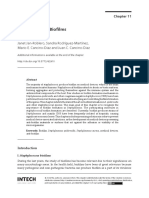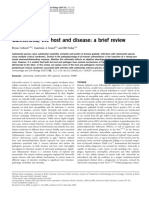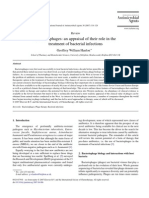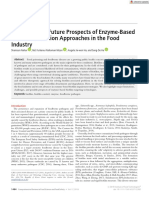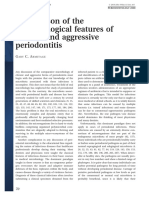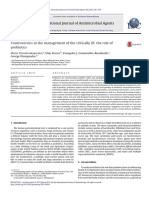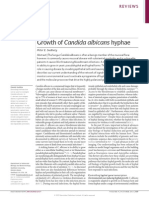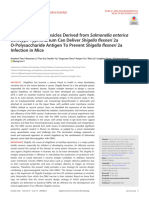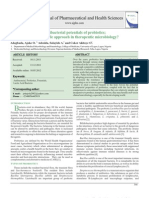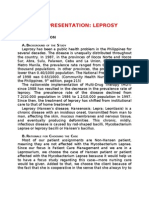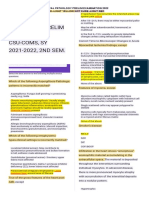Professional Documents
Culture Documents
A Comprehensive Review On The Development of Salmonella Biofilm On Gallbladder Surface
Original Title
Copyright
Available Formats
Share this document
Did you find this document useful?
Is this content inappropriate?
Report this DocumentCopyright:
Available Formats
A Comprehensive Review On The Development of Salmonella Biofilm On Gallbladder Surface
Copyright:
Available Formats
Volume 7, Issue 6, June – 2022 International Journal of Innovative Science and Research Technology
ISSN No:-2456-2165
A Comprehensive Review on the Development of
Salmonella Biofilm on Gallbladder Surface
Soumyashreeta Nayak Kankana Ray Chaudhuri
Biotechnology Biotechnology
Kalinga Institute of Industrial Technology Kalinga Institute of Industrial Technology
Bhubaneswar, Odisha, India Bhubaneswar, Odisha, India
Shinjini Dasgupta
Biotechnology
Kalinga Institute of Industrial Technology
Bhubaneswar, Odisha, India
Abstract:- Salmonella is a group of rod-shaped bacteria that get implicated in many chronic infections and are known
belonging to the family Enterobacteriaceae. They are to ease the process of bacterial persistence by increasing
gram-negative and facultatively anaerobic. These bacteria resistance against the microbes and interfering with the host
reside mainly in the intestinal tract of humans and other immune response [5,6,8,9]. Biofilms are encased within a
animals. The pathogen, Salmonella enterica serovar Typhi mixture of secreted and cell wall-associated poly-saccharides,
primarily causes typhoid fever, a disease specific to glycoproteins, and glycolipids, as well as extracellular DNA,
humans. Salmonella can exist in the human gallbladder in known collectively as extracellular polymeric substances (EPS)
an asymptomatic carrier state. Salmonella species have the [5,7]. Biofilms are frequently associated with implanted
capability to form biofilms. The production of biofilms devices, such as catheters, prosthetics, and contact lenses [8,9].
serves as an advantage because bacteria in the biofilm are For patients with gallstones, antibiotic treatment against
resistant to chemical, physical, and mechanical stresses as Salmonella generally becomes ineffective and elimination of
well as disinfectants. Biofilm formation also assists in gallbladder infection in these individuals usually requires
Salmonella virulence. It is because the bacterial biofilm surgery and gallstone removal [10]. In addition to this, biofilm
serves as a resistant barrier to antibiotics and immune production by S. Typhi may be regarded as a key factor for the
attacks by the host. This results in a chronic infection promotion of persistent infection in the gallbladder, thus
accompanied by the development of Salmonella carrier enduring a chronic local inflammatory response and exposing
state. In this review, we present a comprehensive overview the epithelium to repeated damage caused by carcinogenic
of Salmonella biofilm formation, factors affecting biofilm toxins.
formation, complications arising from biofilm formation,
and available treatments for biofilm-mediated infections. Salmonella biofilm formation depends on certain genes,
environmental factors, the presence of flagella, fimbriae, bile,
Keywords:- Salmonella; Biofilm Formation; Gall Bladder; and quorum sensing. Quorum sensing is being used in many
Typhoid; Antibiotic Resistance; Factors; Complication; different bacteria as a mechanism for cell signaling based on
Treatment. cell density which is thought to regulate a variety of processes,
such as conjugation, virulence, motility, and biofilm formation
I. INTRODUCTION [11,12,13,14,15,16].
Salmonella enterica serovar Typhimurium is a primary According to the Centre for Disease Control and
enteric pathogen that infects both humans and animals [1]. Prevention (CDC) Salmonella bacteria causes about 1.35
Salmonella Typhimurium and Typhi are the best-characterized million infections, 26,500 hospitalizations, and 420 deaths in
serovars. It is seen that S. Typhimurium is involved in the United States every year. Even with the use of adequate
localized gastroenteritis in many hosts while S. Typhi causes a antibiotic therapy typhoid records a mortality rate of (2-3) %.
systemic human-specific disease [2]. These are a diverse group Controlled human infection models (CHIMs) have played an
of pathogens that have evolved themselves to survive in a wide important role in accelerating the development of conjugate
range of environments and across multiple hosts [3]. Although vaccines against Salmonella Typhi [17].
non-typhoidal Salmonella mainly causes gastroenteritis,
typhoidal serovars (S. Typhi and S. Paratyphi A) are known to The recent evolution of S. Typhi, which is a multidrug-
cause typhoid fever, the treatment of which is threatened due resistant (MDR) strain has evolved as a notable problem for
to increasing drug resistance of the pathogen [4]. People patients as low-priced and readily available antibiotics like
suffering from typhoid develop diarrhea, fever, and abdominal streptomycin, chloramphenical, ampicillin and trimethoprin-
cramps within 8 to 72 hours. sulfamethoxazole are often unproductive against them [18,19].
Although hostility to ciprofloxacin, which is a second-
S. Typhi and S. Typhimurium are capable of forming generation fluoroquinolone is increasing, medical
bacterial biofilms in mammalian and/or environmental niches. practitioners still recommend it as first-line therapy for
Biofilms are mainly aggregated mixtures of sessile bacteria children and adults [20,21,22].
IJISRT22JUN752 www.ijisrt.com 295
Volume 7, Issue 6, June – 2022 International Journal of Innovative Science and Research Technology
ISSN No:-2456-2165
Epidemiological studies in regions where S. Typhi is Formation of Salmonella biofilm depends on the action
endemic revealed that the greater part of chronically infected of certain genes. Moreover, it has been seen that the presence
carriers also harbor gallstones, which in turn, have been of flagella, fimbriae, and bile can affect biofilm formation.
indicated as a primary predisposing factor for the onset of Quorum sensing is another mechanism that favors microbial
gallbladder cancer. But now, it is well recognized that S. Typhi interactions and regulation of population-level virulence of
strain produces a typhoid toxin with a carcinogenic potential bacteria.
that induces DNA damage and cell cycle alterations in
intoxicated cells. Genes involved in biofilm regulation
In stressful conditions, S. Typhi can use the biofilm
II. BIOFILM FORMATION ON THE GALL phenotype in order to increase the production of the membrane
BLADDER SURFACE matrix, protect and adhere to the surface, and enter an energy-
conserving state [29].
In humans, Salmonella enterica serovar Typhi can cause
an asymptomatic and persistent infection of the gallbladder, The galE gene is crucial for the formation of wild-type
indicating that this strain uses novel mechanisms to increase biofilms. galE encodes for a uridine diphosphogalactose-4-
colonization in bile-rich environments. Gallstones are among epimerase, which is a structural gene needed for the synthesis
the most dangerous threats to growing carriage, and formerly of galactose, that is added to both the outer core and the O-
in some of the studies, it has been confirmed in vitro that there antigen. This gene mutation results in a lipopolysaccharide
are Salmonellae-shaped biofilms on gallstones. As a result, we (LPS) that lacks all sugars beyond the heptose region of its
can infer that gallstone surfaces formed by bile-induced internal core (thus producing a tough or incomplete LPS) [25].
biofilms are colonized by gallbladder bacteria [23]. Gallstones,
in particular, are commonly associated with chronic typhoid Gene STY0893, a bssR gene involved in biofilm
carriage when they develop in the gallbladder [24]. regulation, is significantly downregulated within the biofilm
cells. In a study, researchers compared the bssR gene in E. coli
The organism infects the intestinal epithelium, invades and Salmonella. The bssR gene, also called yliH in E. coli cells,
macrophages, and spreads throughout the body [25]. The becomes upregulated during biofilm formation [30]. The
organism may colonize the liver and then shed into the transcriptome study on S. Typhi biofilm cells, however,
gallbladder, where it chronically colonizes the gallbladder confirmed that the BssR gene (STY0893) was markedly
wall [26,10]. The persistent colonization of S. Typhi with downregulated compared to planktonic cells. The BLAST
gallstones and gallbladder cancer is associated with persistent analysis of E. coli K-12 and S. Typhi CT18 showed that the
colonization of these organisms, but it is not known whether gene bssR is found in both species, although it has only 75%
this organism is a causal factor in gallstone formation or nucleotide similarity. Additionally, since the base pair length
whether gallstones promote persistent colonization. Several of both species differs, it is likely that both proteins are unique
recent studies indicate that S. Typhi forms bacterial biofilms [30].
on cholesterol gallstones. It is possible that this biofilm
formation could allow persistent colonization and protect the The gene which codes for biofilm stress and motility
organism as the organism is treated with antibiotics. The protein A is Yjfo gene. According to a study conducted on E.
formation of biofilms requires the presence of bile, as coli, yjfO was related to cellular survival based on the
organisms not cultured with bile would not form biofilms [26]. formation of biofilms in response to peroxide pressure [31].
Comparison of the outcomes of the study using statistics
In Salmonella carriers, the growth of a biofilm may shows that S. Typhi has an exclusive feature for the gene yjfO
protect microorganisms from antimicrobial agents and because the gene becomes downregulated in S. Typhi during
excessive levels of bile for an extended period of time. Bile biofilm formation. The yjfO gene is also responsible for
acids are amphipathic molecules, surface active, and are a kind microcolony formation. It is also possible that the gene
of detergent. As a detergent, bile acids have strong transcription rate can become suppressed in mature biofilm
antimicrobial activity [27]. The absence of bacterial biofilm on tissues.
S. Typhi gallstones suggests that S. Typhi followed a similar
strategy, by forming a biofilm on the gallstone surface, Flagella
enabling it to persist inside the gallbladder for many years and The presence of flagella has been proven to be very crucial
assist in shedding and reattachment, followed by diffusion to biofilm formation, especially during the early stages when
through urine and feces [28]. A number of studies have shown microcolonies are being formed. In order to propel
that people with gallstones who are infected with S. enterica microorganisms throughout the surface, flagella are required
serovar Typhi are much more likely to develop the infection to move them to the surface, for attachment, and to propel
and become carriers than people without gallstones, who do them to find different microorganisms. Some research has
not have obvious gallbladder abnormalities [28,7]. This been conducted to determine if flagella play a part in
indicates that gallstones are involved in chronic disease Salmonella biofilm formation on gallstones. It was found that
development. Gallstones are strong and stable surfaces and can a mutant showed a severe defect in the ability to form flagella
act as a firmly attached organism that can avoid being washed (and therefore non-motile) which were analyzed using
away into the surrounding tissues due to the continuous a scanning electron microscope (SEM). After 14 days of
emptying of the gallbladder. growth, a weak biofilm was observed. However, the
IJISRT22JUN752 www.ijisrt.com 296
Volume 7, Issue 6, June – 2022 International Journal of Innovative Science and Research Technology
ISSN No:-2456-2165
phenotype differed significantly from that of the S. regulator which is very crucial for biofilm production and it
enterica serovar Typhimurium wild kind [25]. also regulates the csgBAC operon, cellulose, and the BapA
protein [44,45].
Researchers have demonstrated that motility is crucial to
biofilm development on glass using the motA and fliA mutants Quorum sensing
of S. Typhimurium [25,32]. However, it has been defined that Cell-cell communication is achieved by a process known
Salmonella mutants with defective flagella (flhC or flgE) as quorum sensing, which depends on gene expression in
cannot form complete biofilms in the presence of bile [33,34]. response to population cell density. A quorum-sensing signal
Earlier, works involving QseBC two-component system (TCS) is activated in Salmonella biofilms, and this signal triggers the
functioning in S. Typhimurium found out that QseBC plays a maturation and disassembly of the biofilm in an organised
role in flagella formation, biofilm formation, and virulence manner. As part of quorum sensing, acylated homoserine
mechanism [35,36,37]. Recent research has proven that the lactone signaling molecules are produced, released, and
cyclic di-guanylate monophosphate (c-di-GMP) receptor detected in the environment. These molecules are known as
YcgR and the phosphodiesterase YhjH can distinctively autoinducers [46]. Several studies have confirmed that S.
inhibit flagellar motility in S. Typhimurium [38]. Therefore, enterica serovar Typhimurium has a homologue for luxS, an
flagellar motility plays a very important role in the autoinducer-2 gene [15,16]. The autoinducer has been
development of Salmonella biofilm. implicated in supporting the transformation of pathogenic
bacteria to free-living bacteria within the surrounding
Salmonella flagella can also additionally play a significant environment [15].
role in EPS secretion or production. In addition, it also helps
in establishing primary adhesion and microcolony formation Bile
(aided by using bacterial movement throughout the surface) on The gall bladder is responsible for storing bile in the
gallstones [25]. human body. It has been hypothesized that bile can also be
used as a signal to induce biofilm formation. In a mouse model
Fimbriae study, gallstones had been incubated within the presence of LB
Fimbriae play a role in the adhesion of the microorganism broth alone and LB broth containing 3% bile. The presence of
to different microorganisms and to the surface of the bile facilitates complete biofilm formation on gallstones after
gallbladder. A fimbria-mediated attachment on the surface 14 days in S. enterica serovar Typhimurium and S. enterica
indicates the initiation of a microcolony. The fimbriae of serovar Typhi cultures, while the absence of bile prevents the
different organisms participate in the formation of biofilms as formation of biofilm [25]. Thus, Salmonella biofilm formation
well. Various S. enterica serovar Typhimurium fimbrial on gallstones is dependent on bile within the culture medium.
mutants have been tested in association with gallstones and Bile is necessary for biofilm formation on gallstones in 14
strains with individual mutations in four fimbrial operons (fim, days, so it is possible that bile gives the signal to the
agf, lpf, and pef). In addition, a strain wherein all these four microorganism to form biofilm and makes the surfaces of the
mutations were combined and tested for gallstone biofilm gallstones smooth, making adhesion easier [10].
formation [39]. The fim operon encodes a type I fimbria that is
peritrichous and agf operon encodes a thin aggregative fimbria III. ENVIRONMENTAL FACTORS AFFECTING
which is also peritrichous in nature. A lpf operon encodes polar SALMONELLA BIOFILM FORMATION
fimbriae, which are essential for virulence, while a pef operon
is on a plasmid and is needed for adhesion to organ surfaces Biofilm formation is a complicated process that begins
[25]. with the initial adherence of bacterial cells to the substratum,
leading to physiological changes within the microbe and
The DT104 strain of S. enterica serovar Typhimurium multiplication of attached cells to form microcolonies, and
exhibits a rugose phenotype on certain media, which gives finally leads to maturation of the biofilm [47]. Bacteria that
prominence to its biofilm-forming ability. SR11 strain shows have the ability to form biofilms present distinct features as
a rugose phenotype, but it overproduces an EPS that allows compared to their planktonic counterparts which are free-
rapid biofilm formation. living, such as different physiology and high resistance to the
immune system and antibiotics. Hence, biofilms serve as a key
A biofilm matrix of Salmonella is mainly composed of factor in chronic and persistent infections [48]. It has been seen
curli fimbriae, the O-antigen capsule, cellulose, colanic acid, that the change of phenotype from planktonic to the sessile
vi-antigen, and biofilm-related proteins [40,41]. The essential form occurs when there are changes in environmental
protein element is curli fimbria, which is crucial for biofilm conditions [49]. Nutrient level, temperature, pH, oxygen
formation and it plays an important role in virulence and concentration and osmolarity are the key environmental
alterations to the immune system [42,43]. Curli fibers are factors that can affect biofilm formation through several
much like eukaryotic amyloid fibers and are involved in pathways [50]. In order to obtain the best nutrients to survive
molecular aggregation and adhesion. Curli genes are and reproduce, mature biofilms change with environmental
organized in divergent curli-particular gene (csg) operons with conditions [51].
independent promoters: one consists of the structural
components CsgA and CsgB (csgBAC), and the second
consists of the CsgD, which acts as regulator and different
structural proteins (csgDEFG). CsgD is a transcriptional
IJISRT22JUN752 www.ijisrt.com 297
Volume 7, Issue 6, June – 2022 International Journal of Innovative Science and Research Technology
ISSN No:-2456-2165
pH glucose has been reported to slow down the biofilm formation
The environmental pH can highly influence the formation in Salmonella. It is suspected that glucose inhibits a
of biofilms [50]. The first step in biofilm formation is component required in the early phase of bacterial adhesion
microbial adhesion to surfaces. It has been seen that this step [64].
is influenced by environmental pH [52,53]. pH is considered
as an important factor in the initial adhesion to surfaces in Osmolarity
bacteria, such as Staphylococcus epidermidis [54]. One study Bacteria are exposed to osmolarity which is one of the
showed that the optimal pH for Salmonella biofilm formation abiotic stresses. In Salmonella species, biofilm formation is
is pH 7.0. However, biofilm formation was significantly inhibited when there is an increase in NaCl concentrations
reduced at pH 10.0. Salmonella biofilm formation is inhibited [65]. In a study, it was found that when the growth medium
at alkaline pH however most cells can survive the alkaline was supplemented with a low concentration of sodium
stress [55]. chloride (0.5 to 2%), biofilm formation was slightly enhanced
for the strain S. enterica serovar Enteritidis 110. However,
Temperature biofilm formation by the strain S. enterica serovar Newport
The formation of biofilm is also affected by temperature. 193 was sharply reduced or abolished [66].
Optimum temperature can enhance bacterial growth and assist
in the rapid formation of biofilm. However, when optimum IV. COMPLICATIONS ARISING FROM BIOFILM
temperature is not present, bacterial growth can be decreased, FORMATION ON GALL BLADDER SURFACE
due to a reduction in reaction rates, and as a result, the biofilm
development might be affected [56]. The biofilm formation Salmonella typhi forms biofilm on cholesterol gallstones
of V.parahaemolyticus is temperature-dependent. It has been which is surface-specific and bile dependent, but this stage
seen that a higher temperature range (15°C to 37°C) gives rise results in a carrier state. Gallstones are one of the most critical
to stronger biofilm formation, but a lower temperature (4°C or risk elements for growing carriage states. Once the carrier state
10°C) induces the monolayer adherance of bacterial cells [57]. is formed, biofilm is tough to treat [23,67].
In one paper, among the 243 analyzed Salmonella strains, 224
(92.2 %) were able to produce biofilm in atleast one of the Most biofilm infections are persistent, as biofilm-residing
tested temperature conditions, but to various extents. It was microorganisms may be resistant to the immune system,
seen that there is a strong influence of temperature on biofilm antibiotics, and various treatments. During their dormant
production as strains showed different behaviors at different phase, bacteria can infect nearby tissues, which can later cause
incubation temperatures [58]. acute infection. The microorganisms within the biofilm adapt
to environmental anoxia and nutrient deficiency by changing
Oxygen Concentration their metabolism, gene expression, and protein production,
Oxygen availability can also affect biofilm formation as it resulting in a reduced metabolic rate and slowing down the
determines bacterial energy production. If there is a production molecular division process [68].
of microenvironments within biofilms, such as reduced
oxygen zones or restricted nutrient diffusion through the Biofilms might additionally have a major role to play in
biofilm, it leads to slow growth of the bacteria. Deficiency in the colonization and chronic persistence of S. Typhi. This
oxygen and nutrient within biofilms often results in a decrease notion is supported using numerous reviews and researches
in bacterial metabolic activity and termination of bacterial that bile, a lipid-rich, detergent-like digestive secretion with
growth [59]. Hence, this state does not provide sufficient antimicrobial characteristics contained within the gallbladder,
energy to maintain cell attachment. As a result, detachment induces an exopolysaccharide matrix O-antigen production
occurs. For example, the presence of oxygen is required for the that allows S. Typhi biofilm formation on human gallstones
formation of biofilm in some microbes, such as E. coli. The [23,69]. Gallstones can block the tubes (ducts) via which bile
lack of oxygen can act as a signal for detachment for the cells flows out of the gallbladder or liver into the gut. As a result,
[60]. Another study demonstrated that the biofilm formation severe pain, jaundice, and bile duct contamination can also
of Salmonella on stainless steel is highly influenced by oxygen occur.
levels [61].
Biofilm embedded gallstones might also additionally
Nutrient Level constitute favorable surroundings for bacterial persistence
It has been seen that bacterial attachment to surfaces is also within the gallbladder and might result in reseeding of the gut
influenced by the availability of nutrients in the surrounding bacteria and fecal shedding, followed by transmission to a new
medium; thus, an increase in nutrient concentration increases host and exposing the gallbladder epithelium to bacterial
the microbial attachment rate. Characteristics like biofilm factors potentially carcinogenic for prolonged periods of time
morphology, biomass, thickness, composition and activity and [70]. Different products like bacterial glucuronidase and
are determined by nutrient availability in the environment. It nitroso compounds are released by S. Typhi, which have the
was shown in one experiment that microbes produced less capacity to promote carcinogenesis [71].
dense biofilms with lower biomass content in batch mode
compared to biofilms formed in continuous mode with
constant supply of nutrients [62]. In some microbes such as E.
coli, biofilm formation is enhanced when glucose is added as
a carbon source to the medium [63]. However, the presence of
IJISRT22JUN752 www.ijisrt.com 298
Volume 7, Issue 6, June – 2022 International Journal of Innovative Science and Research Technology
ISSN No:-2456-2165
V. TREATMENT
Using small molecules of JG-1 and M4
JG-1 and M4 are two compounds that are found to show
effective anti-biofilm activity against Salmonella. S. Typhi
resides in humans and does not colonize mice and S.
Typhimurium, which is a related species is used as a model for
typhoid infection in mice. In a study, the abilities of JG-1 and
M4 was observed using both S. Typhi and S. Typhimurium
grown in a particular media. In S. Typhimurium both
compounds showed similar inhibiting capacity however in S.
Typhi, biofilms were inhibited more efficiently by M4 than
JG-1. In order to detect the anti-biofilm effects of M4 and JG-
1 and whether they could be accredited as bacteriostatic or
bactericidal in nature, the liquid cultures of S. Typhimurium
were incubated. This was done in the presence of a vehicle or
a low/high concentration of either compound for a period of
24 hours. However, no significant differences were observed
with respect to growth progression at any of the time points
assessed [75].
JG-1 and M4 disrupt pre-formed Salmonella biofilms
Destruction of already existing biofilm is of great
importance to therapeutic relevance. Studies were conducted
by exposing S. Typhimurium after 1-2 hours of inoculation to
Fig 1: The development of gallbladder cancer may be related observe the anti-biofilm effects of JG-1 and M4 at various
to biofilm-producing S.Typhi. S. Typhi infection is strongly phases during biofilm formation. When a bare minimum
related to the development of gallstones and gallbladder amount of JG-1 or M4 was added to S. Typhimurium nearly 8
cancer. Gallstones provide S. Typhi strains with an ideal hours after inoculation, both compounds were seen to inhibit
substrate to form biofilms. Biofilm formation may cause biofilm growth and maturation. Then it was tested on 24-hour
bacteria to release carcinogens, which trigger genomic biofilm with the compounds at various concentrations and the
instability and chronic inflammation, which are both results proved that both JG-1 and M4 disrupted the biofilm to
necessary for GC to form. a certain degree but M4 was more efficient in disrupting S.
Typhimurium biofilm than JG-1. In case of S.Typhi, both
Cytolethal distending toxins (CDTs) are toxic bacterial
compounds were equally competent in disrupting the biofilm
molecules produced by S. Typhi, which are capable of causing
[75].
irreversible DNA damage and causing the cell cycle to stop
and apoptosis to occur [72]. Gallbladder infections damage Administration of Ciprofloxacin enhances the biofilm
deoxyribonucleic acid (DNA), leading to repeated tissue disrupting capabilities of JG-1 and M4
growth attempts to reverse the damage, released cytokines and Ciprofloxacin is the first-line therapy for chronic and acute
growth factors, and thus predisposing cells to oncogenic typhoidal infections in majority of countries. Using this agent,
transformation [73]. The characteristics of gallstones further scientists have tried to evaluate the therapeutic potential of JG-
influence the development of gallbladder cancer. As the stone 1 and M4 against Salmonella biofilms. In congruence with the
length increases, the chance of gallbladder cancer increases. prior data, scientists treated 24-hour S. Typhimurium biofilm
Stones that are longer than 3 cm convey a tenfold elevated risk
with some amount of ciprofloxacin but it had no significant
as compared to smaller stones [74].
effect but treatment with JG-1 or M4 caused a major reduction
in biofilm formation. Viewing these results, researchers
S. Typhi appears to utilize biofilm formation as an adaptive further combined M4 or JG-1 with ciprofloxacin and found
strategy in order to facilitate microbial persistence. Therefore, that this combination of drugs amplifies the destructive effects
it ensures the spread of bacteria both within the host and of both compounds despite ciprofloxacin displaying no anti-
community as well as immunity against antibiotics. The biofilm effects on its own [75].
persistence of bacterial toxins on target cells may contribute to
their mutagenic effects, which could additionally cause
cumulative damage and transformation [71].
IJISRT22JUN752 www.ijisrt.com 299
Volume 7, Issue 6, June – 2022 International Journal of Innovative Science and Research Technology
ISSN No:-2456-2165
VI. CONCLUSION
Salmonella biofilm is formed through the action of a few
genes. The quorum-sensing mechanism contributes to
microbial interactions and regulates virulence at a population
level. Gallstone surfaces formed with a biofilm could protect
the microorganism from antimicrobial agents as well as
excessive concentrations of bile for a long time. Flagella of
Salmonella can also be useful for secreting or producing
EPS. It also acts as an aid in primary adhesion and
microcolony formation on gallstones. The fimbriae are
important in the attachment of microorganisms to
microorganisms and to the surface of the gallbladder.
Gallbladder colonization seems to be associated with chronic
Fig 2: Structure of Ciprafloxacin. persistence of S. Typhi caused by biofilm formation on
gallstone surfaces. The main cause of gallbladder cancer in
Combining with ciprofloxacin helps to enhance the individuals with particular predisposing factors is the presence
efficacy of JG-1 and M4 treatment in mice with chronic of chronic S. Typhi infection, despite the presence of
Salmonella gallbladder carriage gallstones. Gallstones are not the only sites where S. Typhi
After experimenting on in-vitro models, scientists have infection can persist; the gallbladder epithelium and other
further addressed Salmonella activity in an in-vivo model. A cavities could also serve as alternative niches. Environmental
specific mouse strain was fed with a lithogenic diet to help in factors affect the formation of Salmonella biofilms to a great
the formation of cholesterol gallstones. Infection with S. extent. Salmonella prefers a neutral pH for biofilm formation.
Typhimurium shows the same result as that of S. Typhi in Biofilm formation also shows a variation at different
humans. Later, in the research, the mouse model was treated temperature ranges. Generally, at higher oxygen and nutrient
with different regimens: JG-1 or M4 alone; ciprofloxacin levels, Salmonella biofilm formation is better whereas a higher
alone; a combination of ciprofloxacin with either JG-1 or M4, salt concentration adversely affects biofilm formation.
and a control was setup. For this purpose, mice were used and Glucose in culture media inhibits biofilm formation
their livers, spleens, and gallbladders were collected for in Salmonella. Studies show that the treatment of chronic
further assessment of Salmonella burden. carriage with anti-biofilm compounds alone may be able to
reduce the burden of bacteria able to produce biofilms in the
The results showed that ciprofloxacin alone did not gallbladder. However, in few cases it may lead to increased
inhibit biofilm growth gallbladder of infected mice but slightly acute disease severity, sepsis, or even death. Further, it is seen
reduced biofilm growth in the liver and spleen. In contrast, M4 that the adverse outcomes can be avoided by using a dual-
or JG-1 alone could reduce the bacterial burden in the therapy approach in which traditional antibiotics like
gallbladder but increased the number of bacteria in the liver ciprafloxacin are administered in combination with anti-
and spleen. This also resulted in an increased mortality rate in biofilm compounds.
mice. The main cause of this was found to be the reduction in
gall-bladder contents, but there was a decline in bacteria Further research has to be done to observe the combined
associated with gall-bladder tissue. The fecal matter was also effect of dual-drug therapy and environmental factors, both in-
tested and it was found to have increased fecal bacteria vivo and in-vitro models. It has already been seen that the dual-
(Salmonella) when treated with the JG-1 or M4 alone than drug therapy approach yields good results. Hence, further
with ciprofloxacin. In in-vitro biofilms, co-administration of studies should be done considering proper environmental
ciprofloxacin with M4 or JG-1 decreases Salmonella burden conditions so that better results may be obtained and the
in the gallbladder as well as in the liver and spleen with no disease can be managed more efficiently. Research should also
associated mortality. Thus, scientists could say that the be carried out to produce a single drug as a substitute to dual
compounds M4 and JG-1 effectively and remarkably reduced or multiple drugs in combination that have been proven to be
chronic carriage in the mouse model [75]. effective against the disease.
Another research was conducted using Compound REFERENCES
7955004 [3-(2-furylmethyl)-2-[[(5-hydroxy-1H-pyrazole-3-yl)
methyl]thio]-3,5,6,7-tetrahydro-4Hcyclopenta[4,5]thieno [1]. Fàbrega, A., & Vila, J. (2013). Salmonella enterica
[2,3- d]pyrimidin-4-on] which inhibits S. Typhimurium serovar Typhimurium skills to succeed in the host:
biofilm formation in a dose-dependent manner. It was seen virulence and regulation. Clinical microbiology
that biofilm formation was dependent on the amount of the reviews, 26(2), 308–341.
compound applied. Compound 7955004 was further tested in https://doi.org/10.1128/CMR.00066-12
S. Typhi and S. Typhimurium for 60 hours. It was observed [2]. Sabbagh, S. C., Forest, C. G., Lepage, C., Leclerc, J. M.,
that biofilm inhibition by S. Typhi was more modest than S. & Daigle, F. (2010). So similar, yet so different:
Typhimurium. Compound 7955004 was again tested to uncovering distinctive features in the genomes of
disperse pre-existing 24-hour biofilms but no significant Salmonella enterica serovars Typhimurium and
decrease in biofilm presence was observed [76].
IJISRT22JUN752 www.ijisrt.com 300
Volume 7, Issue 6, June – 2022 International Journal of Innovative Science and Research Technology
ISSN No:-2456-2165
Typhi. FEMS microbiology letters, 305(1), 1–13. [15]. Surette, M. G., & Bassler, B. L. (1999). Regulation of
https://doi.org/10.1111/j.1574-6968.2010.01904.x autoinducer production in Salmonella
[3]. Foley, S. L., Johnson, T. J., Ricke, S. C., Nayak, R., & typhimurium. Molecular Microbiology, 31(2), 585–595.
Danzeisen, J. (2013). Salmonella pathogenicity and host https://doi.org/10.1046/j.1365-2958.1999.01199.x
adaptation in chicken-associated serovars. Microbiology [16]. Surette, M. G., Miller, M. B., & Bassler, B. L. (1999).
and molecular biology reviews: MMBR, 77(4), 582–607. Quorum sensing in Escherichia coli, Salmonella
https://doi.org/10.1128/MMBR.00015-13 typhimurium, and Vibrio harveyi: a new family of genes
[4]. Johnson, R., Mylona, E., & Frankel, G. (2018). responsible for autoinducer production. Proceedings of
Typhoidal Salmonella: Distinctive virulence factors and the National Academy of Sciences of the United States of
pathogenesis. Cellular microbiology, 20(9), e12939. America, 96(4), 1639–1644.
https://doi.org/10.1111/cmi.12939 https://doi.org/10.1073/pnas.96.4.1639
[5]. Costerton, J. W., Stewart, P. S., & Greenberg, E. P. [17]. Raymond, M., Gibani, M. M., Day, N., & Cheah, P. Y.
(1999). Bacterial biofilms: a common cause of persistent (2019). Typhoidal Salmonella human challenge studies:
infections. Science (New York, N.Y.), 284(5418), 1318– ethical and practical challenges and considerations for
1322. https://doi.org/10.1126/science.284.5418.1318 low-resource settings. Trials, 20(Suppl 2), 704.
[6]. Parsek, M. R., & Singh, P. K. (2003). Bacterial biofilms: https://doi.org/10.1186/s13063-019-3844-z
an emerging link to disease pathogenesis. Annual review [18]. Simon, H. J., & Miller, R. C. (1966). Ampicillin in the
of microbiology, 57, 677–701. treatment of chronic typhoid carriers. Report on fifteen
https://doi.org/10.1146/annurev.micro.57.030502.09072 treated cases and a review of the literature. The New
0 England journal of medicine, 274(15), 807–815.
[7]. Costerton, J. W., Lewandowski, Z., Caldwell, D. E., https://doi.org/10.1056/NEJM196604142741501
Korber, D. R., & Lappin-Scott, H. M. (1995). Microbial [19]. Nolan, C. M., & White, P. C., Jr (1978). Treatment of
biofilms. Annual review of microbiology, 49, 711–745. typhoid carriers with amoxicillin. Correlates of
https://doi.org/10.1146/annurev.mi.49.100195.003431 successful therapy. JAMA, 239(22), 2352–2354.
[8]. Davey, M. E., & O'toole, G. A. (2000). Microbial https://doi.org/10.1001/jama.239.22.2352
biofilms: from ecology to molecular [20]. Thaver, D., Zaidi, A. K., Critchley, J., Azmatullah, A.,
genetics. Microbiology and molecular biology reviews: Madni, S. A., & Bhutta, Z. A. (2009). A comparison of
MMBR, 64(4), 847–867. fluoroquinolones versus other antibiotics for treating
https://doi.org/10.1128/MMBR.64.4.847-867.2000 enteric fever: meta-analysis. BMJ (Clinical research
[9]. Flemming, H. C., Neu, T. R., & Wozniak, D. J. (2007). ed.), 338, b1865. https://doi.org/10.1136/bmj.b1865
The EPS matrix: the "house of biofilm cells". Journal of [21]. Effa, E. E., Lassi, Z. S., Critchley, J. A., Garner, P.,
bacteriology, 189(22), 7945–7947. Sinclair, D., Olliaro, P. L., & Bhutta, Z. A. (2011).
https://doi.org/10.1128/JB.00858-07 Fluoroquinolones for treating typhoid and paratyphoid
[10]. Lai, C. W., Chan, R. C., Cheng, A. F., Sung, J. Y., & fever (enteric fever). The Cochrane database of
Leung, J. W. (1992). Common bile duct stones: a cause systematic reviews, 2011(10), CD004530.
of chronic salmonellosis. The American journal of [22]. Zavala Trujillo, I., Quiroz, C., Gutierrez, M. A., Arias, J.,
gastroenterology, 87(9), 1198–1199. & Renteria, M. (1991). Fluoroquinolones in the treatment
[11]. De Kievit, T. R., Gillis, R., Marx, S., Brown, C., & of typhoid fever and the carrier state. European journal
Iglewski, B. H. (2001). Quorum-sensing genes in of clinical microbiology & infectious diseases: official
Pseudomonas aeruginosa biofilms: their role and publication of the European Society of Clinical
expression patterns. Applied and environmental Microbiology, 10(4), 334–341.
microbiology, 67(4), 1865–1873. https://doi.org/10.1007/BF01967008
https://doi.org/10.1128/AEM.67.4.1865-1873.2001 [23]. Crawford, R. W., Gibson, D. L., Kay, W. W., & Gunn, J.
[12]. Miller, M. B., & Bassler, B. L. (2001). Quorum sensing S. (2008). Identification of a bile-induced
in bacteria. Annual review of microbiology, 55, 165–199. exopolysaccharide required for Salmonella biofilm
https://doi.org/10.1146/annurev.micro.55.1.165 formation on gallstone surfaces. Infection and immunity,
[13]. Parsek, M. R., & Greenberg, E. P. (2000). Acyl- 76(11), 5341–5349. https://doi.org/10.1128/IAI.00786-
homoserine lactone quorum sensing in gram-negative 08
bacteria: a signaling mechanism involved in associations [24]. Crawford, R. W., Rosales-Reyes, R., Ramírez-Aguilar,
with higher organisms. Proceedings of the National M., Chapa-Azuela, O., Alpuche-Aranda, C., & Gunn, J.
Academy of Sciences of the United States of S. (2010). Gallstones play a significant role in
America, 97(16), 8789–8793. Salmonella spp. gallbladder colonization and carriage.
https://doi.org/10.1073/pnas.97.16.8789 Proceedings of the National Academy of Sciences of the
[14]. Schauder, S., Shokat, K., Surette, M. G., & Bassler, B. L. United States of America, 107(9), 4353–4358.
(2001). The LuxS family of bacterial autoinducers: https://doi.org/10.1073/pnas.1000862107
biosynthesis of a novel quorum-sensing signal [25]. Prouty, A. M., Schwesinger, W. H., & Gunn, J. S. (2002).
molecule. Molecular Microbiology, 41(2), 463–476. Biofilm formation and interaction with the surfaces of
https://doi.org/10.1046/j.1365-2958.2001.02532.x gallstones by Salmonella spp. Infection and immunity,
70(5), 2640–2649.
https://doi.org/10.1128/IAI.70.5.2640-2649.2002
IJISRT22JUN752 www.ijisrt.com 301
Volume 7, Issue 6, June – 2022 International Journal of Innovative Science and Research Technology
ISSN No:-2456-2165
[26]. Dutta, U., Garg, P. K., Kumar, R., & Tandon, R. K. [37]. Ji, Y., Li, W., Zhang, Y., Chen, L., Zhang, Y., Zheng, X.,
(2000). Typhoid carriers among patients with gallstones Huang, X., & Ni, B. (2017). QseB mediates biofilm
are at increased risk for carcinoma of the gallbladder. The formation and invasion in Salmonella enterica serovar
American journal of gastroenterology, 95(3), 784–787. Typhi. Microbial pathogenesis, 104, 6–11.
https://doi.org/10.1111/j.1572-0241.2000.01860.x https://doi.org/10.1016/j.micpath.2017.01.010
[27]. Gunn J. S. (2000). Mechanisms of bacterial resistance [38]. Le Guyon, S., Simm, R., Rehn, M., & Römling, U.
and response to bile. Microbes and infection, 2(8), 907– (2015). Dissecting the cyclic di-guanylate
913. https://doi.org/10.1016/s1286-4579(00)00392-0 monophosphate signaling network regulating motility in
[28]. Gonzalez-Escobedo, G., & Gunn, J. S. (2013). Salmonella enterica serovar Typhimurium.
Identification of Salmonella enterica serovar Environmental Microbiology, 17(4), 1310–1320.
Typhimurium genes regulated during biofilm formation https://doi.org/10.1111/1462-2920.12580
on cholesterol gallstone surfaces. Infection and [39]. van der Velden, A. W., Bäumler, A. J., Tsolis, R. M., &
immunity, 81(10), 3770–3780. Heffron, F. (1998). Multiple fimbrial adhesins are
https://doi.org/10.1128/IAI.00647-13 required for full virulence of Salmonella typhimurium in
[29]. Chin, K., Taylor, T. D., Hebrard, M., Anbalagan, K., mice. Infection and immunity, 66(6), 2803–2808.
Dashti, M. G., & Phua, K. K. (2017). Transcriptomic https://doi.org/10.1128/IAI.66.6.2803-2808.1998
study of Salmonella enterica subspecies enterica serovar [40]. Gonzalez-Escobedo, G., Marshall, J. M., & Gunn, J. S.
Typhi biofilm. BMC genomics, 18(1), 836. (2011). Chronic and acute infection of the gall bladder by
https://doi.org/10.1186/s12864-017-4212-6 Salmonella Typhi: understanding the carrier state. Nature
[30]. Domka, J., Lee, J., & Wood, T. K. (2006). YliH (BssR) reviews. Microbiology, 9(1), 9–14.
and YceP (BssS) regulate Escherichia coli K-12 biofilm https://doi.org/10.1038/nrmicro2490
formation by influencing cell signaling. Applied and [41]. Tursi, S. A., & Tükel, Ç. (2018). Curli-Containing
environmental microbiology, 72(4), 2449–2459. Enteric Biofilms Inside and Out: Matrix Composition,
https://doi.org/10.1128/AEM.72.4.2449-2459.2006 Immune Recognition, and Disease Implications.
[31]. Weber, M. M., French, C. L., Barnes, M. B., Siegele, D. Microbiology and molecular biology reviews: MMBR,
A., & McLean, R. (2010). A previously uncharacterized 82(4), e00028-18.
gene, yjfO (bsmA), influences Escherichia coli biofilm https://doi.org/10.1128/MMBR.00028-18
formation and stress response. Microbiology (Reading, [42]. Adcox, H. E., Vasicek, E. M., Dwivedi, V., Hoang, K.
England), 156(Pt 1), 139–147. V., Turner, J., & Gunn, J. S. (2016). Salmonella
https://doi.org/10.1099/mic.0.031468-0 Extracellular Matrix Components Influence Biofilm
[32]. Huber, B., Riedel, K., Köthe, M., Givskov, M., Molin, Formation and Gallbladder Colonization. Infection and
S., & Eberl, L. (2002). Genetic analysis of functions immunity, 84(11), 3243–3251.
involved in the late stages of biofilm development in https://doi.org/10.1128/IAI.00532-16
Burkholderia cepacia H111. Molecular Microbiology, [43]. Humphries, A., Deridder, S., & Bäumler, A. J. (2005).
46(2), 411–426. https://doi.org/10.1046/j.1365- Salmonella enterica serotype Typhimurium fimbrial
2958.2002.03182.x proteins serve as antigens during infection of mice.
[33]. Crawford, R. W., Reeve, K. E., & Gunn, J. S. (2010). Infection and immunity, 73(9), 5329–5338.
Flagellated but not hyperfimbriated Salmonella enterica https://doi.org/10.1128/IAI.73.9.5329-5338.2005
serovar Typhimurium attaches to and forms biofilms on [44]. Liu, Z., Niu, H., Wu, S., & Huang, R. (2014). CsgD
cholesterol-coated surfaces. Journal of bacteriology, regulatory network in a bacterial trait-altering biofilm
192(12), 2981–2990. https://doi.org/10.1128/JB.01620- formation. Emerging microbes & infections, 3(1), e1.
09 https://doi.org/10.1038/emi.2014.1
[34]. Tsai, M. H., Liang, Y. H., Chen, C. L., & Chiu, C. H. [45]. Römling, U., Rohde, M., Olsén, A., Normark, S., &
(2020). Characterization of Salmonella resistance to bile Reinköster, J. (2000). AgfD, the checkpoint of
during biofilm formation. Journal of microbiology, multicellular and aggregative behavior in Salmonella
immunology and infection = Wei mian yu gan ran za zhi, typhimurium regulates at least two independent
53(4), 518–524. pathways. Molecular Microbiology, 36(1), 10–23.
https://doi.org/10.1016/j.jmii.2019.06.003 https://doi.org/10.1046/j.1365-2958.2000.01822.x
[35]. Merighi, M., Septer, A. N., Carroll-Portillo, A., Bhatiya, [46]. Schauder, S., Shokat, K., Surette, M. G., & Bassler, B. L.
A., Porwollik, S., McClelland, M., & Gunn, J. S. (2009). (2001). The LuxS family of bacterial autoinducers:
Genome-wide analysis of the PreA/PreB (QseB/QseC) biosynthesis of a novel quorum-sensing signal molecule.
regulon of Salmonella enterica serovar Typhimurium. Molecular Microbiology, 41(2), 463–476.
BMC microbiology, 9, 42. https://doi.org/10.1186/1471- https://doi.org/10.1046/j.1365-2958.2001.02532.x
2180-9-42 [47]. Puttamreddy, S., Cornick, N. A., & Minion, F. C. (2010).
[36]. Bearson, B. L., Bearson, S. M., Lee, I. S., & Brunelle, B. Genome-wide transposon mutagenesis reveals a role for
W. (2010). The Salmonella enterica serovar pO157 genes in biofilm development in Escherichia coli
Typhimurium QseB response regulator negatively O157:H7 EDL933. Infection and immunity, 78(6), 2377–
regulates bacterial motility and swine colonization in the 2384. https://doi.org/10.1128/IAI.00156-10
absence of the QseC sensor kinase. Microbial
pathogenesis, 48(6), 214–219.
https://doi.org/10.1016/j.micpath.2010.03.005
IJISRT22JUN752 www.ijisrt.com 302
Volume 7, Issue 6, June – 2022 International Journal of Innovative Science and Research Technology
ISSN No:-2456-2165
[48]. Wei, Q., & Ma, L. Z. (2013). Biofilm matrix and its [60]. Bjergbæk, L.A., Haagensen, J., Reisner, A., Molin, S., &
regulation in Pseudomonas aeruginosa. International Roslev, P. (2006). Effect of oxygen and growth medium
journal of molecular sciences, 14(10), 20983–21005. on in vitro biofilm formation by Escherichia
https://doi.org/10.3390/ijms141020983 coli. Biofilms, 3, 1-10.
[49]. Rossi, C., Chaves-López, C., Serio, A., Goffredo, E., [61]. Lamas, A., Regal, P., Vázquez, B.I., Miranda, J.M.,
Goga, B. T., & Paparella, A. (2016). Influence of Cepeda, A., & Franco, C.M. (2018). Influence of milk,
Incubation Conditions on Biofilm Formation chicken residues and oxygen levels on biofilm formation
by Pseudomonas fluorescens Isolated from Dairy on stainless steel, gene expression and small RNAs in
Products and Dairy Manufacturing Plants. Italian Salmonella enterica. Food Control.
journal of food safety, 5(3), 5793. [62]. Salgar-Chaparro, S. J., Lepkova, K., Pojtanabuntoeng,
https://doi.org/10.4081/ijfs.2016.5793 T., Darwin, A., & Machuca, L. L. (2020). Nutrient Level
[50]. Agarwal, R.K., Singh, S., Bhilegaonkar, K.N., and Determines Biofilm Characteristics and Subsequent
Singh, V.P. (2011). Optimization of microtitre plate Impact on Microbial Corrosion and Biocide
assay for the testing of biofilm formation ability in Effectiveness. Applied and environmental
different Salmonella serotypes. International Food microbiology, 86(7), e02885-19.
Research Journal. 18. 1493-1498. https://doi.org/10.1128/AEM.02885-19
[51]. Zhao, X., Zhao, F., Wang, J.J., & Zhong, N. (2017). [63]. Bühler, T., Ballestero, S., Desai, M., & Brown, M. R.
Biofilm formation and control strategies of foodborne (1998). Generation of a reproducible nutrient-depleted
pathogens: food safety perspectives. RSC Advances, 7, biofilm of Escherichia coli and Burkholderia
36670-36683. cepacia. Journal of applied microbiology, 85(3), 457–
[52]. Oder, M., Fink, R., Bohinc, K., & Torkar, K. G. (2017). 462. https://doi.org/10.1046/j.1365-2672.1998.853501.x
The influence of shear stress on the adhesion capacity of [64]. White, A. P., Weljie, A. M., Apel, D., Zhang, P.,
Legionella pneumophila. Arhiv za higijenu rada i Shaykhutdinov, R., Vogel, H. J., & Surette, M. G. (2010).
toksikologiju, 68(2), 109–115. A global metabolic shift is linked to Salmonella
https://doi.org/10.1515/aiht-2017-68-2904 multicellular development. PloS one, 5(7), e11814.
[53]. Pompilio, A., Piccolomini, R., Picciani, C., D'Antonio, https://doi.org/10.1371/journal.pone.0011814
D., Savini, V., & Di Bonaventura, G. (2008). Factors [65]. Karaca, B., Akçelik, N., & Akçelik, M. (2012). Biofilm-
associated with adherence to and biofilm formation on producing abilities of Salmonella strains isolated from
polystyrene by Stenotrophomonas maltophilia: the role Turkey. Biologia, 68, 1-10.
of cell surface hydrophobicity and motility. FEMS [66]. Gu, L., Chen, Q., Guo, A., Liu, W., Ruan, Y., Zhang, X.,
microbiology letters, 287(1), 41–47. & Nou, X. (2020). Differential Effects of Growth
https://doi.org/10.1111/j.1574-6968.2008.01292.x Medium Salinity on Biofilm Formation of
[54]. Nostro, A., Cellini, L., Di Giulio, M., D'Arrigo, M., Two Salmonella enterica Strains. Journal of food
Marino, A., Blanco, A. R., Favaloro, A., Cutroneo, G., & protection, 196–203. Advance online publication.
Bisignano, G. (2012). Effect of alkaline pH on https://doi.org/10.4315/0362-028X.JFP-19-418
staphylococcal biofilm formation. APMIS : acta [67]. Hannan, A., Bajwa, A. E., Riaz, S., Arshad, U., Saleem,
pathologica, microbiologica, et immunologica S., & Bajwa, U. I. (2018). In vitro Salmonella typhi
Scandinavica, 120(9), 733–742. biofilm formation on gallstones and its disruption by
https://doi.org/10.1111/j.1600-0463.2012.02900.x Manuka honey. Pakistan Journal of pharmaceutical
[55]. Papakonstantinou, A., & Efthimiou, G. (2020). sciences, 31(1), 129–135.
Investigation of the physiology and architecture of [68]. Vestby, L. K., Grønseth, T., Simm, R., & Nesse, L. L.
Salmonella Enteritidis biofilms under alkaline (2020). Bacterial Biofilm and its Role in the
conditions. Acta Scientific Microbiology, 3(3), 1-11 Pathogenesis of Disease. Antibiotics (Basel,
[56]. Garrett, T.R., Bhakoo, M., & Zhang, Z. (2008). Bacterial Switzerland), 9(2), 59.
adhesion and biofilms on surfaces. Progress in Natural https://doi.org/10.3390/antibiotics9020059
Science, 18, 1049-1056. [69]. Hall-Stoodley, L., & Stoodley, P. (2009). Evolving
[57]. Han, N., Mizan, M.F., Jahid, I.K., & Ha, S. (2016). concepts in biofilm infections. Cellular microbiology,
Biofilm formation by Vibrio parahaemolyticus on food 11(7), 1034–1043. https://doi.org/10.1111/j.1462-
and food contact surfaces increases with rise in 5822.2009.01323.x
temperature. Food Control, 70, 161-166. [70]. Di Domenico, E. G., Cavallo, I., Pontone, M., Toma, L.,
[58]. Borges, K.A., Furian, T.Q., Souza, S.N., Menezes, R.A., & Ensoli, F. (2017). Biofilm Producing Salmonella
Tondo, E.C., Salle, C.T., Moraes, H.L., & Nascimento, Typhi: Chronic Colonization and Development of
V.P. (2018). Biofilm formation capacity of Salmonella Gallbladder Cancer. International journal of molecular
serotypes at different temperature conditions. Pesquisa sciences, 18(9), 1887.
Veterinaria Brasileira, 38, 71-76. https://doi.org/10.3390/ijms18091887
[59]. Anderson, G. G., & O'Toole, G. A. (2008). Innate and [71]. Nath, G., Gulati, A. K., & Shukla, V. K. (2010). Role of
induced resistance mechanisms of bacterial bacteria in carcinogenesis, with special reference to
biofilms. Current topics in microbiology and carcinoma of the gallbladder. World journal of
immunology, 322, 85–105. https://doi.org/10.1007/978- gastroenterology, 16(43), 5395–5404.
3-540-75418-3_5 https://doi.org/10.3748/wjg.v16.i43.5395
IJISRT22JUN752 www.ijisrt.com 303
Volume 7, Issue 6, June – 2022 International Journal of Innovative Science and Research Technology
ISSN No:-2456-2165
[72]. Csendes, A., Becerra, M., Rojas, J., & Medina, E. (2000).
Number and size of stones in patients with asymptomatic
and symptomatic gallstones and gallbladder carcinoma:
a prospective study of 592 cases. Journal of
gastrointestinal surgery: official journal of the Society
for Surgery of the Alimentary Tract, 4(5), 481–485.
https://doi.org/10.1016/s1091-255x(00)80090-6
[73]. Rakić, M., Patrlj, L., Kopljar, M., Kliček, R., Kolovrat,
M., Loncar, B., & Busic, Z. (2014). Gallbladder cancer.
Hepatobiliary surgery and nutrition, 3(5), 221–226.
https://doi.org/10.3978/j.issn.2304-3881.2014.09.03
[74]. Hundal, R., & Shaffer, E. A. (2014). Gallbladder cancer:
epidemiology and outcome. Clinical epidemiology, 6,
99–109. https://doi.org/10.2147/CLEP.S37357
[75]. Sandala, J. L., Eichar, B. W., Kuo, L. G., Hahn, M. M.,
Basak, A. K., Huggins, W. M., Woolard, K., Melander,
C., & Gunn, J. S. (2020). A dual-therapy approach for the
treatment of biofilm-mediated Salmonella gallbladder
carriage. PLoS pathogens, 16(12), e1009192.
https://doi.org/10.1371/journal.ppat.1009192
[76]. Koopman, J. A., Marshall, J. M., Bhatiya, A., Eguale, T.,
Kwiek, J. J., & Gunn, J. S. (2015). Inhibition of
Salmonella enterica biofilm formation using small-
molecule adenosine mimetics. Antimicrobial agents and
chemotherapy, 59(1), 76–84.
https://doi.org/10.1128/AAC.03407-14
IJISRT22JUN752 www.ijisrt.com 304
You might also like
- Significance of Biofilm Formation by Enteric Escherichia Coli Obtained From Fresh Produce in Increased Antimicrobial Resistance and PersistenceDocument6 pagesSignificance of Biofilm Formation by Enteric Escherichia Coli Obtained From Fresh Produce in Increased Antimicrobial Resistance and PersistenceInternational Journal of Innovative Science and Research TechnologyNo ratings yet
- 7307 12912 1 SMDocument11 pages7307 12912 1 SMRin ChanNo ratings yet
- Literature Review On SalmonellaDocument6 pagesLiterature Review On Salmonellac5r9j6zj100% (1)
- Coidi 31 449Document6 pagesCoidi 31 449Kavyarani RathodNo ratings yet
- Karan 2021Document18 pagesKaran 2021hugoNo ratings yet
- Breaking Down BiofilmsDocument3 pagesBreaking Down Biofilmsleila.hiloutNo ratings yet
- Staphylococcus BiofilmsDocument20 pagesStaphylococcus BiofilmsOssian89No ratings yet
- Atterbury 2011Document10 pagesAtterbury 2011Alex Cristian IonutNo ratings yet
- Immunological, Cellular and Molecular Events in Typhoid FeverDocument12 pagesImmunological, Cellular and Molecular Events in Typhoid FeverAde RifkaNo ratings yet
- Salmonella, The Host and Disease: A Brief ReviewDocument8 pagesSalmonella, The Host and Disease: A Brief ReviewPedro Albán MNo ratings yet
- Bacterio Fag OsDocument11 pagesBacterio Fag OsTatiana CarrilloNo ratings yet
- Bacteriophage in Food SafetyDocument6 pagesBacteriophage in Food SafetySiti Najiha NasahruddinNo ratings yet
- Advances and Future Prospects of Enzyme-Based Biofilm Prevention Approaches in The Food IndustryDocument19 pagesAdvances and Future Prospects of Enzyme-Based Biofilm Prevention Approaches in The Food IndustryhnphnphucNo ratings yet
- Antibiotics 10 00372 v2Document2 pagesAntibiotics 10 00372 v2Ali RazaNo ratings yet
- Helicobacter Pylori Infection in ChildrenDocument11 pagesHelicobacter Pylori Infection in ChildrenCarolina VillagarayNo ratings yet
- H. Pylori - Resp ImuneDocument18 pagesH. Pylori - Resp ImuneCamilla CristinaNo ratings yet
- Microbial features of chronic and aggressive periodontitis comparedDocument19 pagesMicrobial features of chronic and aggressive periodontitis comparedtulusNo ratings yet
- Management and Treatment of Fungal Infection in The Oral CavityDocument4 pagesManagement and Treatment of Fungal Infection in The Oral CavityKIU PUBLICATION AND EXTENSIONNo ratings yet
- Artigo NutriçãoDocument4 pagesArtigo Nutriçãoannakah18No ratings yet
- 1 s2.0 S0882401015001527 MainDocument8 pages1 s2.0 S0882401015001527 MainAndrei AvîrvareiNo ratings yet
- Salmonella Typhi Research PaperDocument5 pagesSalmonella Typhi Research Paperfvf8gc78100% (1)
- Gonorrhea - An Evolving Disease of The New Millennium: ReviewDocument19 pagesGonorrhea - An Evolving Disease of The New Millennium: ReviewValeria Moretto VegaNo ratings yet
- Investigation of Alternative Biocidal Options Against Foodborne Multidrug Resistant Pathogens 2020 MayDocument10 pagesInvestigation of Alternative Biocidal Options Against Foodborne Multidrug Resistant Pathogens 2020 MayWill XiaNo ratings yet
- Maxillofacial MicrobiologyDocument60 pagesMaxillofacial MicrobiologyAbel AbrahamNo ratings yet
- Evaluative Prognosis of Treatment Against Campylobacter Colonization in Poultry by Reverse VaccinologyDocument12 pagesEvaluative Prognosis of Treatment Against Campylobacter Colonization in Poultry by Reverse VaccinologyPratik KaleNo ratings yet
- Uso de Vacunas de ADN vs. Salmonella EntericaDocument10 pagesUso de Vacunas de ADN vs. Salmonella EntericaalferezhassanNo ratings yet
- Biopel Culas de Bacterias Pat Genas 1701969185Document3 pagesBiopel Culas de Bacterias Pat Genas 1701969185Luis Alberto Gonzalez CastilloNo ratings yet
- Helicobacter, Campylobacter, Neisseria BacteriaDocument2 pagesHelicobacter, Campylobacter, Neisseria Bacteriageorginho kingsNo ratings yet
- 2022 - Novel Proteoliposome-Based Vaccine Against E. Coli A Potential New Tool For The Control of Bovine MastitisDocument16 pages2022 - Novel Proteoliposome-Based Vaccine Against E. Coli A Potential New Tool For The Control of Bovine Mastitissoltani59No ratings yet
- Growth of Candida Albicans Hyphae 2011Document12 pagesGrowth of Candida Albicans Hyphae 2011Pikiy PutriNo ratings yet
- Salmonella Typhi ThesisDocument8 pagesSalmonella Typhi Thesisalisonhallsaltlakecity100% (2)
- Literature Review SalmonellaDocument7 pagesLiterature Review Salmonellaafdtbwkhb100% (1)
- Antibiotic Resistance Genes in BacteriaDocument22 pagesAntibiotic Resistance Genes in BacteriaGabriel TrevisanNo ratings yet
- I - Inhibition of Streptococcus Mutans Biofilms With Bacterial-Derived Outer Membrane VesiclesDocument12 pagesI - Inhibition of Streptococcus Mutans Biofilms With Bacterial-Derived Outer Membrane VesiclesHime IbaraNo ratings yet
- Bacteriophage Therapy: An Alternative To Conventional AntibioticsDocument4 pagesBacteriophage Therapy: An Alternative To Conventional AntibioticsAnandNo ratings yet
- International Journal For Parasitology: ArticleinfoDocument16 pagesInternational Journal For Parasitology: ArticleinfoAura-Nicoleta PopinciucNo ratings yet
- Sharma Et Al-2016-Journal of Applied MicrobiologyDocument11 pagesSharma Et Al-2016-Journal of Applied MicrobiologyJoanaNo ratings yet
- 2021 - Oral Biofilm - Development Mechanism, Multidrug Resistance, and Their Effective Management With Novel TechniquesDocument8 pages2021 - Oral Biofilm - Development Mechanism, Multidrug Resistance, and Their Effective Management With Novel TechniquesShraddha JaiswalNo ratings yet
- Safety Aspects of Probiotic ProductsDocument4 pagesSafety Aspects of Probiotic ProductsSrinivas PingaliNo ratings yet
- Antimicrobial Resistance To Disinfectants in Biofilms: P.Araújo, M.Lemos, F.Mergulhão, L. Melo and M.SimõesDocument9 pagesAntimicrobial Resistance To Disinfectants in Biofilms: P.Araújo, M.Lemos, F.Mergulhão, L. Melo and M.SimõesNatalija Atanasova-PancevskaNo ratings yet
- Paper Seminario 02Document18 pagesPaper Seminario 02Hans MenaresNo ratings yet
- Gut MicroDocument2 pagesGut MicroRamesh SarmaNo ratings yet
- 10.1007@s12098-019-03113-0Document5 pages10.1007@s12098-019-03113-0mbilouzi589No ratings yet
- Methods To Isolate Possible Bacteriophage For Micrococcus Luteus and Acinetobacter BaumanniiDocument9 pagesMethods To Isolate Possible Bacteriophage For Micrococcus Luteus and Acinetobacter BaumanniiKanhiya MahourNo ratings yet
- Antibacterial Effects of Fermented and Cold Press VCO Against Aggregatibacter Actinomycetemcomitans and Porphyromonas GingivalisDocument1 pageAntibacterial Effects of Fermented and Cold Press VCO Against Aggregatibacter Actinomycetemcomitans and Porphyromonas GingivalisMonyet...No ratings yet
- Plants 11 01429 v3Document20 pagesPlants 11 01429 v3Parmeshver BhagatNo ratings yet
- Harshada and PranavDocument13 pagesHarshada and PranavPranav NakhateNo ratings yet
- 10 11648 J Ijmb 20210604 12Document15 pages10 11648 J Ijmb 20210604 12Monyet...No ratings yet
- Bakteri S EpidermisDocument15 pagesBakteri S EpidermisSheillaizza FadhillaNo ratings yet
- Pseudomonas Aeruginosa: Virulence Factors: and Antibiotic Resistance GenesDocument15 pagesPseudomonas Aeruginosa: Virulence Factors: and Antibiotic Resistance GenesyutefupNo ratings yet
- Articulo 3 - SalmonellaDocument16 pagesArticulo 3 - SalmonellaJoiver Alean FlórezNo ratings yet
- Asian Journal of Pharmaceutical and Health SciencesDocument6 pagesAsian Journal of Pharmaceutical and Health SciencesadesidasolaNo ratings yet
- International Wound Journal - 2018 - Percival - Role of Anaerobes in Polymicrobial Communities and Biofilms ComplicatingDocument7 pagesInternational Wound Journal - 2018 - Percival - Role of Anaerobes in Polymicrobial Communities and Biofilms ComplicatingIdamelis Rodríguez GarcíaNo ratings yet
- Siddiqui 2021 Combating Biofilm by Targeting Its Formation and DispersalDocument13 pagesSiddiqui 2021 Combating Biofilm by Targeting Its Formation and DispersalSyed Sohail AhmadNo ratings yet
- 2021 Article 624Document18 pages2021 Article 624icrgNo ratings yet
- The Role of Bacterial Biofilm in Persistent Infections and Control StrategiesDocument8 pagesThe Role of Bacterial Biofilm in Persistent Infections and Control StrategiesJenny TaylorNo ratings yet
- 395-404 5.55.15 PM 6.22.13 PM 6.23.17 PMDocument10 pages395-404 5.55.15 PM 6.22.13 PM 6.23.17 PMSaiful AbdulNo ratings yet
- Management of Disease and Disorders by Prebiotics and Probiotic Therapy: Probiotics in Bacterial VaginosisDocument9 pagesManagement of Disease and Disorders by Prebiotics and Probiotic Therapy: Probiotics in Bacterial Vaginosissiska tiaraNo ratings yet
- Biofilm Intracelular 2020Document9 pagesBiofilm Intracelular 2020Gabriela ChaconNo ratings yet
- Parastomal Hernia: A Case Report, Repaired by Modified Laparascopic Sugarbaker TechniqueDocument2 pagesParastomal Hernia: A Case Report, Repaired by Modified Laparascopic Sugarbaker TechniqueInternational Journal of Innovative Science and Research TechnologyNo ratings yet
- Smart Health Care SystemDocument8 pagesSmart Health Care SystemInternational Journal of Innovative Science and Research TechnologyNo ratings yet
- Visual Water: An Integration of App and Web to Understand Chemical ElementsDocument5 pagesVisual Water: An Integration of App and Web to Understand Chemical ElementsInternational Journal of Innovative Science and Research TechnologyNo ratings yet
- Air Quality Index Prediction using Bi-LSTMDocument8 pagesAir Quality Index Prediction using Bi-LSTMInternational Journal of Innovative Science and Research TechnologyNo ratings yet
- Smart Cities: Boosting Economic Growth through Innovation and EfficiencyDocument19 pagesSmart Cities: Boosting Economic Growth through Innovation and EfficiencyInternational Journal of Innovative Science and Research TechnologyNo ratings yet
- Parkinson’s Detection Using Voice Features and Spiral DrawingsDocument5 pagesParkinson’s Detection Using Voice Features and Spiral DrawingsInternational Journal of Innovative Science and Research TechnologyNo ratings yet
- Predict the Heart Attack Possibilities Using Machine LearningDocument2 pagesPredict the Heart Attack Possibilities Using Machine LearningInternational Journal of Innovative Science and Research TechnologyNo ratings yet
- Impact of Silver Nanoparticles Infused in Blood in a Stenosed Artery under the Effect of Magnetic Field Imp. of Silver Nano. Inf. in Blood in a Sten. Art. Under the Eff. of Mag. FieldDocument6 pagesImpact of Silver Nanoparticles Infused in Blood in a Stenosed Artery under the Effect of Magnetic Field Imp. of Silver Nano. Inf. in Blood in a Sten. Art. Under the Eff. of Mag. FieldInternational Journal of Innovative Science and Research TechnologyNo ratings yet
- An Analysis on Mental Health Issues among IndividualsDocument6 pagesAn Analysis on Mental Health Issues among IndividualsInternational Journal of Innovative Science and Research TechnologyNo ratings yet
- Compact and Wearable Ventilator System for Enhanced Patient CareDocument4 pagesCompact and Wearable Ventilator System for Enhanced Patient CareInternational Journal of Innovative Science and Research TechnologyNo ratings yet
- Implications of Adnexal Invasions in Primary Extramammary Paget’s Disease: A Systematic ReviewDocument6 pagesImplications of Adnexal Invasions in Primary Extramammary Paget’s Disease: A Systematic ReviewInternational Journal of Innovative Science and Research TechnologyNo ratings yet
- Terracing as an Old-Style Scheme of Soil Water Preservation in Djingliya-Mandara Mountains- CameroonDocument14 pagesTerracing as an Old-Style Scheme of Soil Water Preservation in Djingliya-Mandara Mountains- CameroonInternational Journal of Innovative Science and Research TechnologyNo ratings yet
- Exploring the Molecular Docking Interactions between the Polyherbal Formulation Ibadhychooranam and Human Aldose Reductase Enzyme as a Novel Approach for Investigating its Potential Efficacy in Management of CataractDocument7 pagesExploring the Molecular Docking Interactions between the Polyherbal Formulation Ibadhychooranam and Human Aldose Reductase Enzyme as a Novel Approach for Investigating its Potential Efficacy in Management of CataractInternational Journal of Innovative Science and Research TechnologyNo ratings yet
- Insights into Nipah Virus: A Review of Epidemiology, Pathogenesis, and Therapeutic AdvancesDocument8 pagesInsights into Nipah Virus: A Review of Epidemiology, Pathogenesis, and Therapeutic AdvancesInternational Journal of Innovative Science and Research TechnologyNo ratings yet
- Harnessing Open Innovation for Translating Global Languages into Indian LanuagesDocument7 pagesHarnessing Open Innovation for Translating Global Languages into Indian LanuagesInternational Journal of Innovative Science and Research TechnologyNo ratings yet
- The Relationship between Teacher Reflective Practice and Students Engagement in the Public Elementary SchoolDocument31 pagesThe Relationship between Teacher Reflective Practice and Students Engagement in the Public Elementary SchoolInternational Journal of Innovative Science and Research TechnologyNo ratings yet
- Investigating Factors Influencing Employee Absenteeism: A Case Study of Secondary Schools in MuscatDocument16 pagesInvestigating Factors Influencing Employee Absenteeism: A Case Study of Secondary Schools in MuscatInternational Journal of Innovative Science and Research TechnologyNo ratings yet
- Dense Wavelength Division Multiplexing (DWDM) in IT Networks: A Leap Beyond Synchronous Digital Hierarchy (SDH)Document2 pagesDense Wavelength Division Multiplexing (DWDM) in IT Networks: A Leap Beyond Synchronous Digital Hierarchy (SDH)International Journal of Innovative Science and Research TechnologyNo ratings yet
- Diabetic Retinopathy Stage Detection Using CNN and Inception V3Document9 pagesDiabetic Retinopathy Stage Detection Using CNN and Inception V3International Journal of Innovative Science and Research TechnologyNo ratings yet
- Advancing Healthcare Predictions: Harnessing Machine Learning for Accurate Health Index PrognosisDocument8 pagesAdvancing Healthcare Predictions: Harnessing Machine Learning for Accurate Health Index PrognosisInternational Journal of Innovative Science and Research TechnologyNo ratings yet
- Auto Encoder Driven Hybrid Pipelines for Image Deblurring using NAFNETDocument6 pagesAuto Encoder Driven Hybrid Pipelines for Image Deblurring using NAFNETInternational Journal of Innovative Science and Research TechnologyNo ratings yet
- Formulation and Evaluation of Poly Herbal Body ScrubDocument6 pagesFormulation and Evaluation of Poly Herbal Body ScrubInternational Journal of Innovative Science and Research TechnologyNo ratings yet
- The Utilization of Date Palm (Phoenix dactylifera) Leaf Fiber as a Main Component in Making an Improvised Water FilterDocument11 pagesThe Utilization of Date Palm (Phoenix dactylifera) Leaf Fiber as a Main Component in Making an Improvised Water FilterInternational Journal of Innovative Science and Research TechnologyNo ratings yet
- The Making of Object Recognition Eyeglasses for the Visually Impaired using Image AIDocument6 pagesThe Making of Object Recognition Eyeglasses for the Visually Impaired using Image AIInternational Journal of Innovative Science and Research TechnologyNo ratings yet
- The Impact of Digital Marketing Dimensions on Customer SatisfactionDocument6 pagesThe Impact of Digital Marketing Dimensions on Customer SatisfactionInternational Journal of Innovative Science and Research TechnologyNo ratings yet
- Electro-Optics Properties of Intact Cocoa Beans based on Near Infrared TechnologyDocument7 pagesElectro-Optics Properties of Intact Cocoa Beans based on Near Infrared TechnologyInternational Journal of Innovative Science and Research TechnologyNo ratings yet
- A Survey of the Plastic Waste used in Paving BlocksDocument4 pagesA Survey of the Plastic Waste used in Paving BlocksInternational Journal of Innovative Science and Research TechnologyNo ratings yet
- Cyberbullying: Legal and Ethical Implications, Challenges and Opportunities for Policy DevelopmentDocument7 pagesCyberbullying: Legal and Ethical Implications, Challenges and Opportunities for Policy DevelopmentInternational Journal of Innovative Science and Research TechnologyNo ratings yet
- Comparatively Design and Analyze Elevated Rectangular Water Reservoir with and without Bracing for Different Stagging HeightDocument4 pagesComparatively Design and Analyze Elevated Rectangular Water Reservoir with and without Bracing for Different Stagging HeightInternational Journal of Innovative Science and Research TechnologyNo ratings yet
- Design, Development and Evaluation of Methi-Shikakai Herbal ShampooDocument8 pagesDesign, Development and Evaluation of Methi-Shikakai Herbal ShampooInternational Journal of Innovative Science and Research Technology100% (3)
- Small Ruminant Nutritional DiseaseDocument11 pagesSmall Ruminant Nutritional DiseasePrince PrinceNo ratings yet
- Acute Urinary RetentionDocument28 pagesAcute Urinary RetentionJuan JoséNo ratings yet
- Cellular Aberration QuizDocument7 pagesCellular Aberration QuizTherese Melchie SantuyoNo ratings yet
- Heart Rate Variability Study Comparing Hypertensive and Normotensive SubjectsDocument107 pagesHeart Rate Variability Study Comparing Hypertensive and Normotensive SubjectsNepoo ChiNo ratings yet
- 2021ITE Answers-2Document80 pages2021ITE Answers-2إكرام النايبNo ratings yet
- Anxiety: Psychiatric DisordersDocument21 pagesAnxiety: Psychiatric DisordersNdoo NdooNo ratings yet
- Gastroesophageal Reflux Disease (GERD) : Patient Population: Objective: Key PointsDocument12 pagesGastroesophageal Reflux Disease (GERD) : Patient Population: Objective: Key PointsRavindraNo ratings yet
- Phillipine Herbal MedicineDocument23 pagesPhillipine Herbal MedicineCENTHREE MAGALLANESNo ratings yet
- 1 PBDocument11 pages1 PBNis RinaNo ratings yet
- NCLEX Nursing Exam Cram SheetDocument9 pagesNCLEX Nursing Exam Cram SheetJodie OrangeNo ratings yet
- Chapter 29: Sensory Function My Nursing Test Banks Chapter 29: Sensory Function Meiner: Gerontologic Nursing, 5th Edition Multiple ChoiceDocument9 pagesChapter 29: Sensory Function My Nursing Test Banks Chapter 29: Sensory Function Meiner: Gerontologic Nursing, 5th Edition Multiple ChoiceAshley Jane MacapayadNo ratings yet
- Day 10-11 - NCM 109 Lec - High Risk Post PartumDocument41 pagesDay 10-11 - NCM 109 Lec - High Risk Post PartumGrey KnighttNo ratings yet
- Nursing Care Plan for a Male Patient with Pleural EffusionDocument48 pagesNursing Care Plan for a Male Patient with Pleural EffusionNo EulNo ratings yet
- Health Impact Assessment: A Case Study On Renovation of A SlaughterhouseDocument7 pagesHealth Impact Assessment: A Case Study On Renovation of A SlaughterhouseJungkook taekookNo ratings yet
- Dr. Abhineet Mehrotra: Curriculum VitaeDocument5 pagesDr. Abhineet Mehrotra: Curriculum Vitaesin67438No ratings yet
- Advanced Radiography and Ultrasonography in ReptilesDocument7 pagesAdvanced Radiography and Ultrasonography in ReptilesmiguelNo ratings yet
- 5 - National Clinical Guideline of Dengue Timor Leste - Clean - Final 12 Dec 2022Document93 pages5 - National Clinical Guideline of Dengue Timor Leste - Clean - Final 12 Dec 2022Ahmad FaizNo ratings yet
- The Complete Blood Count Is The Calculation of The Cellular (Formed Elements) of BloodDocument26 pagesThe Complete Blood Count Is The Calculation of The Cellular (Formed Elements) of BloodNabard MhammadNo ratings yet
- Document patient meds, effects, doses, and considerationsDocument1 pageDocument patient meds, effects, doses, and considerationsgeorgeloto12No ratings yet
- Case StudyDocument10 pagesCase StudyARABELLA FUNDARNo ratings yet
- Pre-Procedure Evaluation: Token Anamnesis DateDocument2 pagesPre-Procedure Evaluation: Token Anamnesis DateUMAR KHANNo ratings yet
- Diabetic Care in Acute Febrile IllnessDocument27 pagesDiabetic Care in Acute Febrile IllnessDr-Ajay TripathiNo ratings yet
- Module For Multi-Purpose Workers - Prevention, Screening and Control of Common NCDS - 2Document104 pagesModule For Multi-Purpose Workers - Prevention, Screening and Control of Common NCDS - 2ROHIT DASNo ratings yet
- Gastrointestinal Drugs Guide: Acid Controllers and PathophysiologyDocument104 pagesGastrointestinal Drugs Guide: Acid Controllers and PathophysiologyMarie KrisNo ratings yet
- Leprosy: A Case PresentationDocument36 pagesLeprosy: A Case Presentationjava_biscocho122970% (10)
- Patho OTDocument23 pagesPatho OTBea Y. Bas-ongNo ratings yet
- Executive Order No. 015 Organizing BhertDocument2 pagesExecutive Order No. 015 Organizing Bhert잔돈100% (1)
- Effects From Smoke From Factory - Google SearchDocument1 pageEffects From Smoke From Factory - Google SearchRizq AzmanNo ratings yet
- Comprehension 1 PDFDocument4 pagesComprehension 1 PDFTCL SMART TVNo ratings yet
- AllenDocument2 pagesAllenvasant pandeyNo ratings yet







